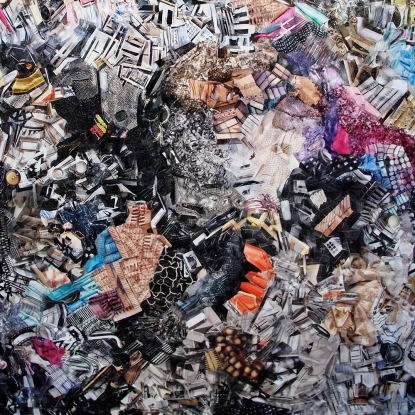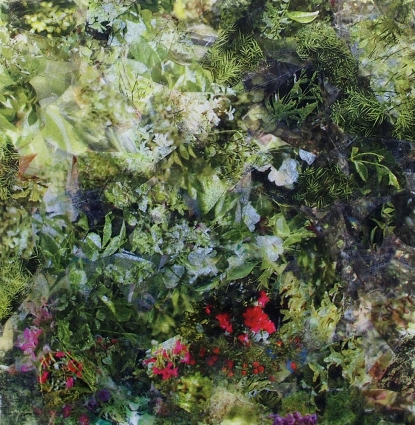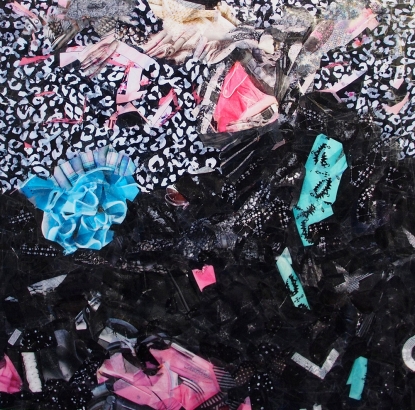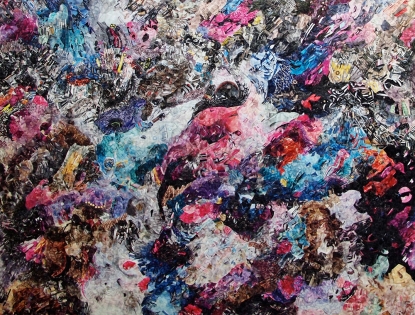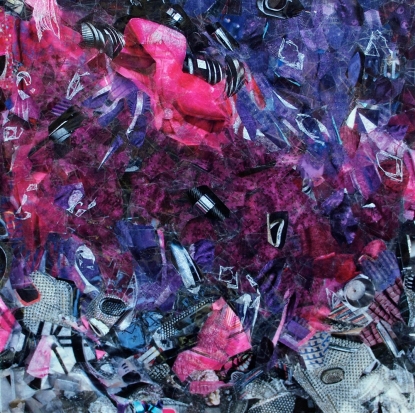Feature: Conversations
A Conversation With Daniel Healey
In my personal experience as a curator and critic, I've encountered few younger artists whose work is as mature and multifaceted as the work of Daniel Healey. I am tempted to utilize an over the top word here and perhaps have in the past socially, when introducing this artist or bringing up his work. He works in painting, collage, sculpture, video and performance art to such a successful degree that I would call it something approaching the state of being a polymath. His stuff is resonant, rough, precise, OCD, cerebral, sensual and he has been invited to do an artist talk with Damon Smith on Cy Twombly at the Menil in Houston in the Spring. In the fall of 2010, I curated what I called the “first comprehensive solo survey show” of Daniel Healey’s work at The Oakbook. He has also exhibited at MASS MoCA, Blankspace, Intersection for the Arts, Krowswork and the Ace Museum. In January, his newest exhibition Sorry Entertainer will open at The McLoughlin Gallery at 49 Geary. I recently had the opportunity to discuss the show and body of work it represents with the artist.
–Theo Konrad Auer
Theo Konrad Auer: Earlier in this series, you seemed to maintain particular forms – specifically evoking tendrils or fingers – in other words, it appears to be more nakedly gestural than the newer work. It has become increasingly abstract. What brought that on?
Daniel Healey: It's interesting that you refer to the earlier work as gestural. I'm assuming you mean the funky shapes that [the] landscapes took on. The older series was semi-abstract and fairly narrative. The reason I feel they might read as gestural has to do with the transfer method literally breaking up the photographs of objects and placing them back together in distorted and jumbled configurations. Movement was always the goal in the feel and end result. Since the process is so abusive to the images, how to evoke expression or gesture from such a slow and arduous procedure was always my aim. The reason the works have become more abstract and arguably more painterly in feel now, is probably related to needing more expression and gesture in the works. To open up the possibilities for the viewer, as well as myself. Perhaps more psychologically than emotively.
TKA: Do you think the viewer will have a similar psychological reaction to your work, that you had while making it?
DH: I don't know, perhaps? I told somebody recently that if a person saw one of my paintings and told me that they thought I was sad, lonely, raving crazy, or that I must get dizzy when shopping at stores; I would say "Jesus, is that what I'm exposing here? You weren't supposed to see that! If you do, I'm trying something different next time.
TKA: In your artist statement you state that you are interested in “...how non-representational work can sequester rational descriptive logic, and reinforce formal qualities of objectivity.” Can you elaborate on that?
DH: When faced with abstraction, especially with non-representational painting, the viewer and maker are forced more toward realms of feelings, and when the feelings don't make sense, the formal qualities I believe become more highlighted. Like looking at a Ryman painting. He only leaves you traces of a process, the material stripped bare, every aspect of the work is reduced yet incredibly concerned. Now you have this object, and it's time to get something out of it, maybe. It's provoking you get something out of it, to ask questions of its legitimacy, yet it only provides you with itself. That's a challenge for most viewers and a beautiful thought I think. It then starts to provoke more questions and feelings than it provides you with those easy answers; hence the painting activates a special cognition between both sides of the brain. Art has this powerful ability to either affirm the viewer or to debase its audience. Often, in my experience, it does both.
TKA: Can you describe your process and how it relates to a subversion of the traditional classifications of painting and collage?
DH: Well first, stealing other people’s pictures of advertised images and using them for abstraction in these works feels subversive. Secondly, I'm playing around with an idea of what painting is. Is it the materials that hold a painting into that classification or is it how we use the material and the process that better describes painting. Schwitters' collages for example use all these really cool painting devices that evoke more Painterliness than his actual paintings do for me. Paint is interesting because you can push and pull it around, layer it translucently, and it adapts easily to gesture, or expressionist marks. My taping process is a sort of random and automatic process of breaking up images used not for their content but for their colors, shapes, form, etc. The catalogs are palettes, not interesting collage material.
The surface is only comprised of the naturally glossy transparent scotch tape and these manipulated abstract pulls of ink from the catalog pages, layered, and presented. Since the transfers have color, transparency, I can work spontaneously and push and pull the colors how I like; very similar to painting processes.
TKA: What do you make of the connection to the physical body with the work particularly when making it? Even though this series of work seems to be least physical of yours, practice-wise – I think it bears some discussion. I know you usually craft these works while on your bed. How did that work when making the larger pieces?
DH: When the size of the canvases gets bigger than the length of my bed, I start to have problems. It's funny because even the largest ones also begin on the bed, leaned up against the wall. They get transferred off the bed once I cannot reach up any higher than what is either a cross legged sitting position or a kneeling position. Both positions hurt like crazy because of my Osgood-Schlatters "knee disorder." I then move to a standing position or use chairs and tables to get every inch of the larger pieces covered and the process becomes more physically active. Like pacing around, thinking, dancing, typical studio like behavior. The bed thing is a bit constricting, uncomfortable, yet comfortable, and almost always involves watching VHS movies directly behind the canvases.
TKA: How important is the idea of “appropriation” to understanding your work?
DH: Appropriation isn't that important to my work, but I feel it to be incredibly important to how one associates the idea of the artist as originator, and the post modern usage of devices to de-mystify the artist. I’m okay with the death of the author! I once asked Mel Ramos if he had been sued over his use of playboy models, or pop usages upon our first encounter. We were not having a great first encounter actually. I was ringing him up for oil paint at an art supply store in Oakland, and I found him to be quite grumpy and unwilling to say a word during the transaction. Upon reading his name on his discount card, I turned my dissatisfied look on my face into an 'oh Mel Ramos' look that said, just fire away a big annoying question at him. He stared at me for a good minute, then smirked, "yeah, twice, one time during a retrospective that used a painting of a model posing in front of a coca cola bottle for its big advertisement for the show." He got a call from cocoa cola headquarters saying he stole their copyright and Mel replied that actually years prior coca cola actually used the same image asking him if it was alright for their public image campaign. We both started laughing, then he broke into another story involving Claudia Schiffer. So priceless was the experience that we became friends instantly and talked more extensively every time I saw him. A sweet thief of an artist. One to remember.
TKA: There is a layered quality to your work, both literally and figuratively. David Hockney said it better than me:
“I mean, photography is all right if you don’t mind looking at the world from the point of view of a paralyzed cyclops—for a split second. But that's not what it’s like to live in the world, or to convey the experience of living in the world.”
How does that idea relate to your idea of how the disassembling of images relates to how we see?
DH: Did Hockney say something about a cyclops? Yeah photography produces lies, just the same as paintings. You just have more options to deceive in paintings because of the limitations of the camera. No biggie, both painting and photography are means of expressing something. That's great! I think Hockney is just referring to the ways of seeing through human eyes, is a breaking of down of images, like snippets or vignettes of information that our minds recollect and recreate into images. That is where a lot of his photomontage stuff I think is coming from. We look at a person for a second, we see their elbow, we look again see there chin, mouth, nose, we look away, look again and notice the hair. This is how we collect a lot of visual information and record our experience. Cameras just focus, collapse space, flatten our surfaces, shadows, lights, and copy or dim the sensibilities of certain things. Drawing and more importantly staring and studying something visually comes very unnaturally to most people.
TKA: Does this work in any way, relate to cubism?
DH: I think the transfer method lends itself quite well with the style of cubism. Breaking up pictures literally, opening up different perspectives, and distorted or skewed pictorial planes all adds to a relationship to cubism. However at times I also try to obscure such obvious influence with my abstractions and attempt to challenge myself and the viewer to other relationships. For example, I've been interested in a specific gap of abstraction that occurred between abstract surrealism and abstract expressionism, stylistically speaking for quite some time and look to achieve this in some of my more recent and visually complex images. There is a flatness and illusionist depth that is in limbo within theses examples, as well as suggested imagery that doesn't quite evoke anything. Arshile Gorky got somewhere close to this effect sometime after being locked so heavily into Picasso's influence.
TKA: I know you read a lot of books on artists, studied Art History/Curatorial Studies as an undergrad, while doing studio practice. Do you search or seriously consider ‘words’ or ‘text’ to accurately describe an " art experience" or an understanding of art?
DH: Fine Art, sorry to have to use that term; is a different language than spoken or written words. Art be a language of its own, and it doesn't provide many answers usually, it gives you another avenue to relationships we have to our experience living. Art doesn’t always require being fully understood. It's quite mad to connect with inanimate objects yet we feel like we need to in order to reconcile this mysterious existence and maybe to connect and relate to things. People often hate not knowing things. This factor adds more viewer tension. Duchamp played that angle very well, understanding that Art and life is more like a game. Does art need to save the world? Of course not. Does it need to justify itself? I think that's for the viewer and object to decide. Words are just the normal way we communicate our justifications for art. They are just one part of the wider understanding, but not the most important one.
TKA: How does film relate to your work? It maintains a cinematic feel, but along the lines of say Fellini – an abstracted stream of sorts.
DH: Movies are fun, film is more complicated. Did Fellini direct Air Force one, or was it that other guy? You know, that other guy who directs and acts; he was in that jewel thief movie I think? Movies just distract me while I'm working, that's one reason I use them I guess? There are probably no great connections to how my pieces look or feel, but sometimes aspects of films enter into titles abstractly. Literal titles usually disengage me, that's probably why I use them as well. I use movies as a form of entertainment as well as for serious content. The same way I use music. Art is a sorry form of entertainment but it provides a lot of serious and absurd gestures.
TKA: This work might possibly decay over time and that process completes the work in way for me. How does that notion, that of aging, factor into your work?
DH: Well, I truly believe these works are more durable than they appear. It's often a concern, not to me so much, but for one who invests in purchasing these works. Which I'm also okay with to certain degrees. Scotch claims their transparent tape that I use does not yellow over time. I construct the pieces by using very good materials underneath the tape that ensure the longevity of the pieces. However they do risk UV light exposure just like most artworks, and I'm certain that if any tape peels up, the pieces can be repaired easily by adding more scotch tape. They require thoughtful collectors and collections that keep them in relative stable conditions, with minimal exposure to light, and some dusting. If they change color or yellow I will embrace them as products of our modern disposition in regard to how the qualities of materials and manufacturing concerns have changed over the last several decades. Art lives, and breathes on in's own terms, regardless of the materials being used. I believe there is a narrowing window of time allowing me to extract ink from the select few catalogs permitting me to do this process, and it won't be accessible later on. My source material is mail order catalogs used for online shopping, and with companies going paperless, the need for such printing is becoming more antiquated.
TKA: The title of the show is Sorry Entertainer. Is that reference to something? What significance does the title of the show and titles of your individual works hold?
DH: Sorry Entertainer is appropriated from a Daniel Johnston song I like. I jokingly said to myself, "wow, going to see a show of very abstract, non-painting, paintings, that are collages sounds like a terrible form of entertainment." I'd rather stay home and watch a movie, or see something fun! Then the self-loathing and telling myself to relax set in, mixed with a strong dash of humor. Individual titles often involve something I can personally relate to, or the viewer can freely associate with. Often these new titles are denoting other forms of media that are far more user friendly than the paintings themselves. "This poem is electric," for example would appear like the work is possibly a poem or influenced by one, which might be the case, but it gives the viewer room to run around with. I like the tension created by words and visual images. We often look for so much sense in words, and for pictures to tell us meaning. That is very limiting for me, so much of life is about communicating clearly and understanding, yet so much of life is about being confused and conflicted about how to use information. Art is a good place for these feelings to play out in many different ways.
Sorry Entertainer – Daniel Healey
January 9 - February 15, 2014
Opening Reception January 9th, 2014 - 6:00 PM to 9:00 PM
The McLoughlin Gallery
49 Geary Street, Suite 200
San Francisco, CA 94108
http://www.mgart.com
http://www.danielhealey.net

